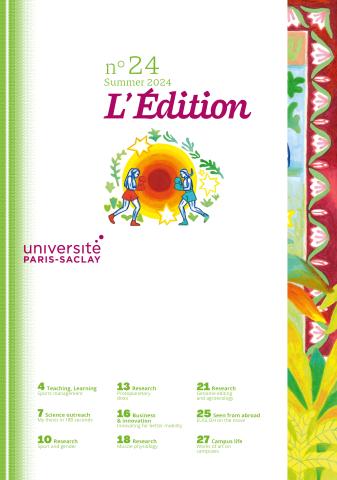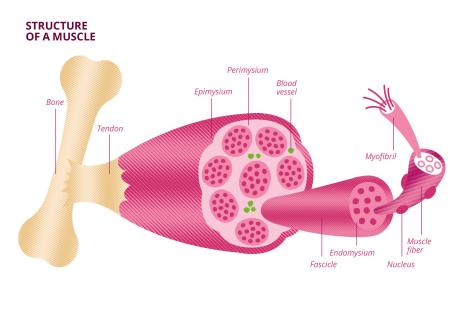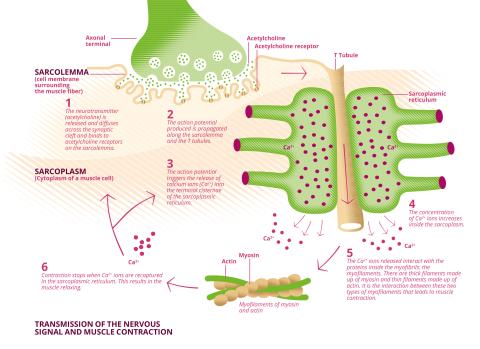
Muscle physiology: How it works, therapies and other mysteries
This article was originally published in L'Édition n°24.
Numbering 639 in the entire human body, skeletal muscles are organs whose primary function is to contract. Made up of muscle fibres grouped together in fasciculi, muscles enable the human body to move or resist an external force. During contraction, the size of the muscle fibres decreases, and with it that of the fasciculus, and thus that of the muscle. How does this complex machinery work? What pathologies affect muscle cells and how can they be treated?
Muscle contraction begins with prior excitation of muscle fibres by motor neurons, at the interface between the muscle and the nervous system. This excitation causes muscle fibres to slide against each other, resulting in contraction and hardening of the muscle, and conversely, relaxation of the organ. At the heart of this complex mechanism lies an essential fuel: adenosine triphosphate (ATP), a nucleotide which, through hydrolysis, provides the energy needed for muscle cell contraction. ATP is synthesised through the aerobic system (using oxygen from the respiratory system), the anaerobic lactic system, or alactic system. The first two metabolic pathways consume glucose, while the last uses creatine during intense exercise.
In the anaerobic-lactic pathway, glucose (coming directly from muscle, blood or liver) is broken down into pyruvate: this is glycolysis. The pyruvate obtained is then the subject of a new chemical reaction leading to the formation of lactate. For a long time, lactate was labelled as a toxic waste product for muscle. It wasn't until 1986 and the work of George Brooks, a researcher at the University of California, Berkeley (USA), that lactate's role as a "shuttle" between different muscle sites was demonstrated. Lactate is mainly produced by fast-twitch muscle fibres and used as an energy substrate by slow-twitch fibres during contraction.
Unlocking the secret of exercise-induced metabolic abnormalities
At the Exercise Biology for Performance and Health Laboratory (LBEPS – Univ. Paris-Saclay/Univ. d'Évry/French Defence Health Service), Claire Thomas-Junius is particularly interested in the anaerobic lactic pathway and the metabolic abnormalities caused by chemical reactions in this metabolic pathway. "During intense exercise, the energy demand of muscles is met by the breakdown of carbohydrates. This process is accompanied by the production of lactate, an accumulation of inorganic phosphate and hydrogen ions (H+), and a decrease in the concentration of bicarbonate ions in the body: metabolic acidosis occurs, a natural phenomenon resulting from the production of energy by the transformation of carbohydrates. My work involves understanding the effects of these metabolic disturbances on the organism and on the onset of fatigue," explains the researcher and director of the LBEPS. "For a long time, the consensus was that lactate was toxic, that this molecule caused cramps. Yet the link between cramps and lactate has never been proven. The paradigm around lactate is changing. It is now considered to be an exerkine; exerkines are a group of molecules produced during exercise that have positive effects on muscle. What's more, lactate is a substrate that is recycled during exercise, saving the human body's glucose reserves," explains the researcher.
Metabolic acidosis, the immediate result of the breakdown of carbohydrates by muscle fibres, is a disorder of the acid-base balance that leads to a drop in pH. In particular, this imbalance has repercussions at the interface between the nerve ending and the muscle fibre, and thus on glycolysis. "The energy produced by the breakdown of sugars will acidify the body," Claire Thomas-Junius explains. "And when the muscle produces a lactate ion, due to its role as a 'shuttle', a proton is transported from the muscle to the bloodstream via a protein system. Finally, thanks to the production of lactate, muscle acidosis is limited." A PhD thesis project launched in October 2023 at the LBEPS is currently focusing on the problem of muscle and adipose tissue communication and the fundamental role of lactates.
Applications of studies to elite athletes
A former middle-distance runner herself, Claire Thomas-Junius began her career as a researcher before joining Université d'Évry in 2005, focusing her research on high-intensity sports training, particularly with top-level athletes. In 2019, the researcher took part in the preparation of the book Sports à haute intensité: mieux comprendre la performance pour mieux l'entraîner (High-intensity sports: a better understanding of performance for better training), published by France's National Institute of Sport, Expertise, and Performance (INSEP). "This book deals with high-intensity sports, based on the duration of effort, the type of effort required (continuous or intermittent) and how to adapt training to each effort, in order to plan specific training sessions for athletes or sedentary people," says the researcher. "Because lactate production varies depending on the intensity of the effort: the more intense the effort, the more the body will produce. Also, the more the effort is repeated, the greater the production. So, in a sense, lactate production is also trained."
In 2020, the researcher and her colleagues took part in tests focused on the French women's judo team, some of the best athletes in the world in their discipline, in preparation for major international competitions, and a year and a half before the Tokyo Olympic and Paralympic Games in 2021. Judokas were monitored after each training match, by collecting data on lactate, bicarbonate ion and blood acidity levels. The results obtained show a lactate concentration in the blood of the sportswomen that is around five times higher at the end of the series of four four-minute training sessions, at virtually the same pH. "Thanks to this study, we were able to better understand metabolic responses to high-intensity exercise. These results justified an intensification of training sessions, while extending recovery times during each training session, a few weeks before the competition," explains Claire Thomas-Junius. Six medals at the World Championships and Junior World Championships immediately following this training, and three Olympic silver medals a few months later, make up these sportswomen's impressive list of achievements. "There are many factors involved in performance," adds the researcher. "Alongside physiology, there's obviously nutrition, psychology, sleep and so on."
Alongside Claire Thomas-Junius, LBEPS PhD candidate François Chiron has recently been working on the effects of stress on sports performance, and on a case study in which he monitored a champion steeplechase runner. The results indicate that monitoring heart rate variations is an important indicator of the athlete's psychophysiological stress. "Stress is reflected in numerous variations in heart rate. It should be noted that this heart rate is not entirely regular. The lower the variability of heart rate, the greater the stress on the body, and vice versa," explains Claire Thomas-Junius. Stress in the body leads to increased risk of injury, as well as impairment of important cognitive functions such as memory, learning or the functioning of hormone-producing neuroendocrine cells.
Claire Thomas-Junius and her colleagues also worked in partnership with the French Rowing Federation (FFA). "The Federation's physical trainers were wondering what type of training to put in place, particularly with young athletes, to guide them towards the Paris 2024 Olympic Games and especially the 2028 Olympics. Should training be personalised for each case, or conversely, generalised for the whole Federation?" says Claire Thomas-Junius. "We finally realised that, depending on how far into puberty young people are, their metabolic and physiological responses are completely different, both in girls and boys. As a result, it was not advisable to give everyone the same training sessions. It's extremely interesting to incorporate this notion of biological age, based on puberty and its peak, instead of 'chronological' age," the researcher summarises.
This new paradigm is already inspiring junior competitions, where fairer rankings are starting to appear. "The French Ski Federation (FFS) recently included a ranking of biological age rather than chronological age following a slalom competition. A young boy who would have finished 30th in the initial rankings ended up first in his category. This new calculation, based on the progress of their growth, is very rewarding for young sportsmen and sportswomen," says Claire Thomas-Junius.
At the same time, Claire Thomas-Junius and her team are also taking a close interest in the use of a new parameter to collect the information needed to monitor and assess the physiology of sportsmen and sportswomen: saliva. "It's virtually non-invasive, and gives us access to information on stress levels, the state of the body, thanks in particular to the cortisone-testosterone ratio, the subjects' state of fitness, and so on," explains the director of the laboratory. Saliva samples were taken during the French Athletics Championships in summer 2023, and the results are currently being processed.
A career devoted to studying human endurance
Véronique Billat joined Université d'Évry in 1988, devoting her career to studying physical exercise and its physiology. "My work focuses on understanding how to optimise energy according to each individual's physiological profile. At any age, I believe it's possible to improve aerobic energy by varying speeds, both in training and in competition," summarises the researcher, who has been monitoring track and field and marathon champions for several years. The scientist recently studied the differences in pacing strategy between two disciplines with very different environments: swimming and running. "Depending on the technique and situation, whether swimming, running, cycling or even walking, the human body achieves the same maximum oxygen consumption (VO2 max). However, the effort made will not be translated into the same running or swimming speeds, for example," Véronique Billat explains.
A university champion cross-country skier and runner, the researcher now helps both high-performance athletes and amateur sportsmen and sportswomen achieve their goals. In 2017, she supervised the training of 105-year-old Robert Marchand, before he set a world record for the distance cycled in one hour (over 22 kilometres).
Today, Véronique Billat is very interested in the animal model and in possible comparisons between human beings and animals. "My idea is to compare, in an interdisciplinary way, animal and human models in real-life situations. I'm studying energy optimisation in a variety of environmental situations (altitude, temperature, etc.), trying to take into account the spontaneous reactions of animals," she explains.
Can physical exercise be a therapy for neuromuscular diseases?
Still at LBEPS, which he joined in 2021 as a winner of the Genopole Thematic Incentive Actions (Atiges) scheme, Olivier Biondi has been studying neuromuscular diseases and the innovative therapies that address them for over fifteen years. "This encompasses therapies for diseases affecting the motor neuron, in the spinal cord or central nervous system, through to neuropathies, affecting the axons, the part of the neuron that conducts nerve information to the target cells. Myopathies, for example, damage the muscle," explains the researcher. "Until now, I've mainly worked on two neurodegenerative diseases, which are very important in the world of sport." The first, amyotrophic lateral sclerosis (ALS) or Charcot's disease, has a particular history with the world of sport: intensive physical exercise is considered to be a factor favouring the onset of the disease, the prevalence of which is greatly multiplied in high-performance sportsmen and sportswomen compared with the average for the general population. "The other pathology is infantile-onset spinal muscular atrophy (SMA), which affects children," continues the biologist. "I've always been interested in the effect of physical exercise on pathologies that more or less prohibit exercise: when you have motor neurone or muscle disorders, the medical recommendations are rarely physical exercise, for fear of aggravating the symptoms."
The research that Olivier Biondi and his team are carrying out aims to combine physical exercise and therapy for neuromuscular diseases. "The idea is to use exercise as a potential therapy, with daily patient management, and at the same time to use exercise as a means of highlighting faulty biological or cellular pathological mechanisms," says the researcher. "My aim is to see to what extent physical exercise helps patients suffering from myopathies, and in particular muscular dystrophies, when muscle morphology is damaged," he summarises.
This raises the question of what type of physical exercise is best suited to each pathology. It's essential to match exercise sessions to the specific characteristics of each disease, as Olivier Biondi explains: "If we take the example of Duchenne muscular dystrophy, a serious genetic disease affecting children that causes the rupture or alteration of the link between the muscle cell and the rest of the muscle, it's difficult to do physical exercise without pulling on this weakened structure and causing cell degradation. There are over 30 different dystrophies, all of which affect different genes and muscle cells in a different way. But using physical exercise, at intensities and with mechanical constraints adapted to each pathology, is always an option."
Using animal and cellular models, Olivier Biondi and his team are seeking to determine the optimal conditions in which to do physical exercise for a specific disease, with the aim of stemming a vicious circle that can aggravate the sometimes paralysing symptoms of pathologies. "As a result of reduced muscle function, patients take less exercise or even stop moving completely. And by moving less, muscles deteriorate even more," adds the biologist.
Combinatorial therapies as a solution to genetic neuromuscular pathologies?
While the use of physical exercise in the treatment of neuromuscular diseases would represent a step forward in the care of many patients, these therapies will never be curative. Alongside his studies on the contribution of physical exercise to therapies for neuromuscular diseases, Olivier Biondi is interested in the development of combinatorial methods, at the interface between genetics and the work of his team. "We're working with Genethon, a laboratory specialising in gene therapy set up by the French Muscular Dystrophy Association (AFM) and based in Évry, on techniques to 'bring back' the healthy gene into the muscles of patients suffering from genetic neuromuscular pathologies – muscles which then contain a mutated gene at the origin of the disease," he explains.
The most promising approach uses adeno-associated viruses (AAVs) as vectors carrying healthy genes to the targeted muscle fibres. Viruses are recombinant: they are produced from pieces of DNA to reduce or eliminate their toxicity to the subject. However, this practice is limited in several ways, as Olivier Biondi points out: "First of all, to reach all muscles, it is now compulsory to use high-dose intravenous injections, i.e. to inject a very large quantity of virus, to try and reach as many muscles as possible. This is then a problem for the liver, as it threatens the functioning of the liver, a real 'virus sponge'. There's also a concern about heterogeneity: nowadays, despite the use of high-dose intravenous injections, it's difficult to target all the muscle fibres in the human body and in the same proportions."
The aim of Olivier Biondi's team is to find ways of optimising the penetration of AAVs into muscles, as well as the expression of the genes introduced, in order ultimately to completely cure the disease and its symptoms. "We believe that physical exercise offers great added value. Thanks to exercise, we have the capacity to change the proteins on the surface of muscle cells, and thus, why not, to facilitate access for AAVs," foresees the researcher.
References:
Thomas C. et al., The effect of preexercise alkalosis on lactate/pH regulation and mitochondrial respiration following sprint-interval exercise in humans. Front. Physiol. 2023.
Chiron F. et al., Application of Vagal-mediated heart rate variability and subjective markers to optimise training prescription: An Olympic Athlete Case Report. Int J Disabil Sports Health Sci, 2021.
El Khoury M. et al., NADPH oxidase 4 inhibition is a complementary therapeutic strategy for spinal muscular atrophy. Front. Cell. Neurosci. 2023.
Demarie, S. et al., Pacing of Human Locomotion on Land and in Water: 1500 m Swimming vs. 5 000 m Running. Appl. Sci. 2023.

This article was originally published in L’Édition No. 24.
Find out more about the journal in digital version here.
For more articles and topics, subscribe to L'Édition and receive future issues:
Subscribe


